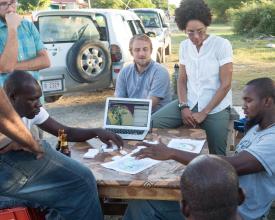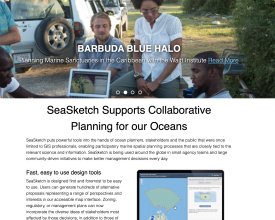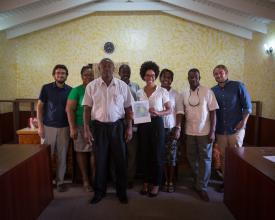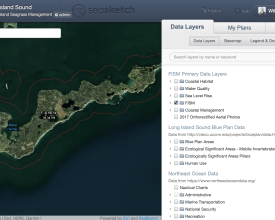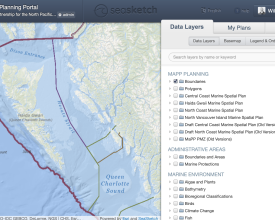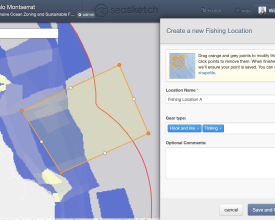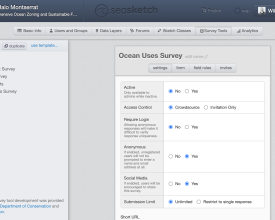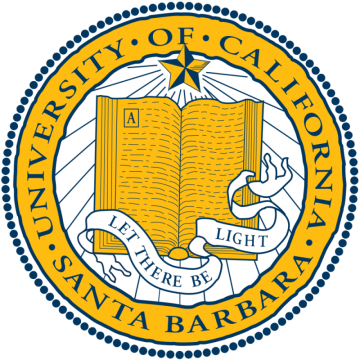
SeaSketch: Una herramienta web para la ordenación participativa del espacio marino
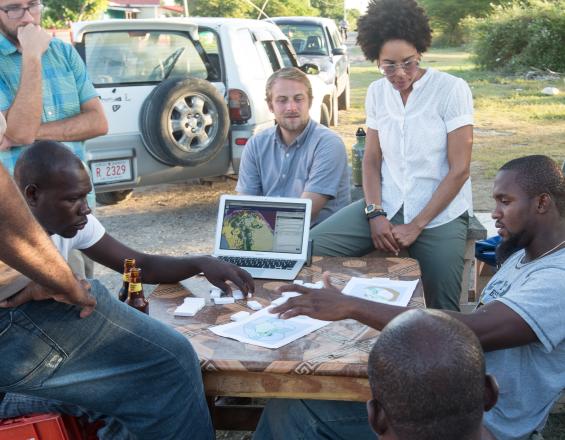
SeaSketch es un servicio informático de cartografía participativa y colaborativa. Mediante herramientas sencillas, los usuarios pueden (1) visualizar y consultar mapas, (2) aportar conocimientos e identificar áreas valoradas mediante encuestas basadas en mapas, (3) esbozar y evaluar posibles escenarios de zonificación y (4) compartir y debatir planes de zonificación en un foro de debate basado en mapas. La plataforma se ha utilizado en muchos casos para desarrollar escenarios de zonificación exhaustivos que reflejan los valores de las partes interesadas en la ordenación del espacio marino (OEM). La herramienta es actualmente de propiedad y requiere la compra de una licencia, pero en enero de 2022 se lanzará una nueva versión gratuita y de código abierto.
Contexto
Défis à relever
Uno de los principales retos de la ordenación del espacio marino es maximizar la participación en el proceso de planificación proporcionando herramientas de Sistemas de Información Geográfica (SIG) que puedan ser utilizadas en diversos entornos (a distancia y en persona) por diversos usuarios (técnicos y no técnicos).
Ubicación
Procesar
Resumen del proceso
Los procesos de ordenación del espacio marino (OEM) suelen contar con la ayuda de herramientas de apoyo a la toma de decisiones. Decidir cuáles son las herramientas para cuestiones críticas de la ordenación del espacio marino, como la gestión de datos espaciales y la participación de las partes interesadas, es clave (BB1 - SeaSketch Software as a Service). Los gobiernos necesitan un mandato legal para establecer planes de ordenación del espacio marino (BB2 - Government Buy-In for Collaborative Planning), sin el cual es poco probable que se adopten los planes.
Se empieza por recopilar la mejor información geoespacial disponible (BB3 - Geodatos autorizados y servicios cartográficos). Todos estos datos pueden mostrarse como capas de datos en SeaSketch. Pueden recopilarse nuevos datos mediante encuestas (BB4 - Encuestas de SeaSketch para evaluar el uso del océano). Los resultados de las encuestas pueden mostrar la distribución de las actividades en el océano. Estos mapas pueden considerarse la base de datos "autorizada" con la que los usuarios pueden empezar a planificar.
La principal herramienta de planificación es el "croquis", un elemento prospectivo del plan (BB5 - Croquización y evaluación de zonas prospectivas). Los foros ofrecen un medio para que los usuarios compartan y discutan las zonas prospectivas.
Bloques de construcción
SeaSketch Software como servicio
En la mayoría de los casos, SeaSketch se utiliza para apoyar los esfuerzos de planificación a gran escala en los que los gobiernos han ordenado el establecimiento de un plan espacial marino y en los que es esencial una amplia participación de las partes interesadas. En estos casos, SeaSketch debe ser autorizado por una agencia líder o un socio. SeaSketch puede utilizarse para visualizar datos geoespaciales en forma de servicios cartográficos, recopilar información mediante encuestas, esbozar y discutir planes. Si los planes van a evaluarse mediante análisis, los servicios de geoprocesamiento y los informes deben desarrollarse en nuestro laboratorio. Tenga en cuenta que las instituciones educativas disponen de una licencia gratuita para utilizar SeaSketch con fines estrictamente educativos.
En enero de 2022, lanzaremos la próxima versión de SeaSketch, que será totalmente gratuita y de código abierto. Al igual que en la versión actual, muchas de las funciones de SeaSketch podrán configurarse con un conocimiento o experiencia mínimos en SIG. Los análisis e informes se ejecutarán en lambda y se codificarán utilizando lenguajes de programación como Javascript. Los propietarios de los proyectos podrán, por tanto, configurar su propio proyecto SeaSketch -de principio a fin- sin intervención de nuestro laboratorio. Hay que tener en cuenta, sin embargo, que el marco de geoprocesamiento e informes, aunque gratuito y de código abierto, requerirá una experiencia significativa en programación.
Factores facilitadores
En la actualidad, el organismo ejecutor (como un organismo gubernamental, una fundación o una ONG) debe adquirir la licencia y contratar el desarrollo de la analítica. La versión actual requiere conexión a Internet, pero la próxima incluirá algunas funciones offline. La aplicación satisfactoria de SeaSketch requerirá cierta ayuda de un técnico de SIG, por ejemplo para publicar e importar servicios cartográficos.
Lección aprendida
SeaSketch es muy valioso para crear una atmósfera de transparencia y colaboración, maximizar la participación de las partes interesadas y fundamentar las decisiones en información científica. Los mejores resultados se obtienen cuando SeaSketch se utiliza en combinación con otras herramientas, como aplicaciones SIG de escritorio, análisis de compensación, herramientas de priorización (por ejemplo, Marxan, Prioritizr) y análisis de impacto acumulativo.
Compromiso del Gobierno con la planificación colaborativa
SeaSketch está diseñado para utilizarse principalmente en la planificación colaborativa. Nos hemos centrado en la planificación espacial marina, pero el software puede utilizarse también para la planificación terrestre. Además, el software está pensado para ayudar a generar soluciones de zonificación oceánica. Para que estas zonas tengan un impacto significativo, como la conservación o los beneficios para la economía azul, es necesario que las instituciones del gobierno anfitrión participen en el proceso de planificación. Si las zonas desarrolladas en SeaSketch no se adoptan legalmente, es menos probable que tengan el efecto deseado.
Factores facilitadores
Es esencial un mandato legal para la ordenación del espacio marino, sin el cual es poco probable que se adopten los planes. Además, el éxito de la aplicación de SeaSketch exige un auténtico compromiso con la participación de las partes interesadas a varios niveles. Una cosa es poner en marcha un proyecto SeaSketch con mapas, clases de dibujo, foros y encuestas, y otra muy distinta estructurar un proceso de planificación para que SeaSketch sea utilizado por las partes interesadas. Hay que crear un plan de participación de las partes interesadas para garantizar que éstas hagan un buen uso de la herramienta.
Lección aprendida
Es esencial un mandato legal para la planificación espacial marina colaborativa y que maximice la participación de las partes interesadas. Sin un mandato y un calendario para la planificación, se puede planificar durante años sin generar una solución zonal. El mero hecho de disponer de herramientas de planificación colaborativa no garantizará la participación de las partes interesadas ni que las soluciones reflejen una variedad de intereses de las partes interesadas.
Servicios autorizados de geodatos y mapas
La base de cualquier proyecto SeaSketch es la información geoespacial (mapas) mostrada como servicios cartográficos. No hay requisitos mínimos de datos. Puedes empezar a trabajar con lo que tengas. Los mapas pueden publicarse como servicios REST de Esri (por ejemplo, con ArcGIS Server o ArcGIS online) y servicios cartográficos de código abierto (por ejemplo, WMS, WMTS) y luego importarse a SeaSketch. Los mapas de ejemplo incluyen límites administrativos (por ejemplo, ZEE, mar territorial, AMP existentes), hábitats del fondo marino, batimetría, usos humanos, etc.
Los mapas que decida incluir como capas de datos en SeaSketch dependerán de los objetivos de su proceso. Si está planificando zonas marinas protegidas, rutas de navegación y lugares de acuicultura, es posible que desee cartas náuticas, mapas de hábitats, la distribución de las actividades pesqueras y otras capas que puedan servir de guía a los usuarios en el diseño de sus planes. Las zonas protegidas sólo tienen sentido si protegen eficazmente determinados hábitats, las vías de navegación minimizan las colisiones y maximizan la eficacia, los emplazamientos de acuicultura se sitúan en determinadas zonas de profundidad, etc. En función de cada caso, habrá que evaluar qué datos deben visualizarse como mapas y qué subconjunto de esos datos debe analizarse.
Factores facilitadores
En algunos casos, los datos cartográficos relevantes pueden estar ya publicados como servicios cartográficos y ser accesibles en atlas costeros y otros portales cartográficos. Siempre que estén en los formatos correctos (servicios cartográficos de Esri, WMS, WMTS, etc.), pueden importarse directamente a SeaSketch y mostrarse como capas cartográficas.
En muchos casos, será ventajoso publicar sus propios servicios cartográficos para mostrarlos en SeaSketch. Esto le dará control sobre la cartografía y el rendimiento de los mapas.
Lección aprendida
Los proyectos de éxito suelen contar con un único técnico de SIG que se encarga de localizar los servicios cartográficos existentes, adquirir datos de los proveedores (organismos gubernamentales, ONG, académicos) y generar nuevos servicios cartográficos mediante herramientas estándar de escritorio y cartografía web.
Encuestas SeaSketch para evaluar el uso de los océanos
SeaSketch cuenta con funciones para desarrollar y desplegar encuestas espaciales que, por ejemplo, piden a los usuarios del océano que identifiquen zonas valoradas o importantes (lugares importantes para la pesca, la navegación, el buceo, la acuicultura, los usos tradicionales, etc.). Los resultados de las encuestas pueden utilizarse para crear mapas térmicos que describan la distribución de las zonas valoradas. Estos resultados pueden visualizarse (o no) y analizarse cuando los usuarios dibujen posibles zonas oceánicas para comprender el valor potencial y el impacto de los escenarios de zonificación.
Factores facilitadores
Actualmente, las encuestas SeaSketch sólo funcionan en un ordenador de sobremesa con conexión a Internet. No funciona sin conexión ni en dispositivos móviles. (La próxima versión de SeaSketch, que se lanzará en enero de 2022, será compatible con dispositivos móviles. Poco después también funcionará en modo offline). Por lo tanto, prevea realizar las encuestas en un entorno con conexión a Internet y utilizando un ordenador de sobremesa.
En muchos casos, las encuestas requerirán facilitación, sobre todo cuando la población en general no disponga de ordenadores personales.
Lección aprendida
Aunque es fácil desarrollar una encuesta en SeaSketch, no siempre es fácil hacerlo desde una perspectiva científicamente defendible. Considera la posibilidad de trabajar con un científico social que pueda ayudarte a crear una encuesta que utilice técnicas de encuesta bien establecidas.
Considere la posibilidad de formar un equipo de facilitadores de encuestas que puedan encuestar a las poblaciones locales en persona, reuniéndose con ellas en los muelles, la playa, los cafés, las instituciones, etc. Estos facilitadores deben estar formados para comunicar la estructura del proceso de planificación y, en particular, cómo se tratarán y utilizarán las respuestas a la encuesta en la planificación.
Las encuestas deben ser muy sencillas. Cuanto más sencilla sea la encuesta, mayor índice de respuesta cabe esperar. Los científicos y planificadores suelen estar muy interesados en recabar toda la información posible de las partes interesadas. Resista la tentación de hacer más preguntas de las absolutamente necesarias para implicar adecuadamente a las partes interesadas y llevar a cabo la planificación del espacio marino.
Impactos
El éxito de la planificación depende del compromiso de los gobiernos de maximizar la participación de las partes interesadas, incluyendo la fijación de objetivos, la generación y evaluación de planes y la toma de decisiones. Teniendo esto en cuenta, la plataforma SeaSketch reduce las barreras a la participación y proporciona un medio por el que las partes interesadas pueden ofrecer concretamente sus ideas y opiniones, compartir información y expresar sus valores sobre cómo se gestiona el espacio oceánico. Los planes de zonificación que reflejan estas ideas, valores y opiniones tienen más probabilidades de lograr la aceptación social y, por tanto, mayores posibilidades de aplicación y cumplimiento.
Además, si se ofrece a las partes interesadas la oportunidad de utilizar SeaSketch de forma práctica, comprenderán mejor la información utilizada en la planificación, así como la estructura del propio proceso de planificación. Al ver los mapas, dibujar y evaluar los planes, los usuarios aprecian mejor lo que significa "hábitats" o "distribución del esfuerzo pesquero".
Y, por último, al utilizar los datos y herramientas disponibles en SeaSketch, los usuarios tienen acceso a un lenguaje común en el que pueden colaborar y comunicarse con otros. Una zona etiquetada como "área marina protegida" o "zona prohibida" tiene un significado específico que se refleja en los atributos e informes asociados a ella. De este modo, las partes interesadas tienen claro lo que quieren (o no) cuando comparten sus ideas.
Beneficiarios
Planificadores, partes interesadas y representantes de organismos gubernamentales que participan directamente en la ordenación del espacio marino.
Historia
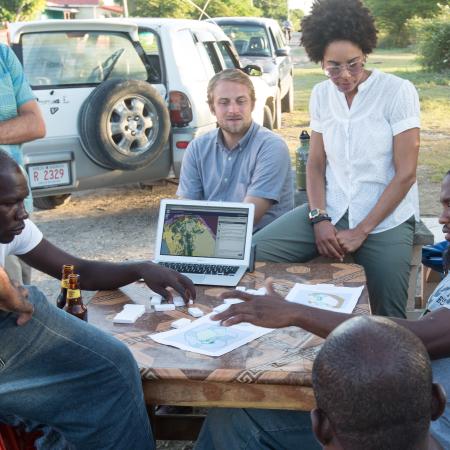
SeaSketch se utilizó en la isla caribeña de Barbuda para crear un plan espacial marino integral. El Consejo de Barbuda (el órgano de gobierno de la isla), con el apoyo invitado del Instituto Waitt, navegó por complejas compensaciones entre usos espaciales para diseñar y codificar legalmente la zonificación de toda su jurisdicción marina. Tras un año de intensa participación de la comunidad en el marco de esta Iniciativa Halo Azul, en agosto de 2014 se adoptaron normas que establecían zonas para santuarios, prohibiciones de redes de pesca, fondeo y navegación. Los datos clave utilizados incluyeron un mapa de hábitats y un mapa de calor del valor de la pesca. Los barbudenses diseñaron todas las zonas, con apoyo técnico, utilizando SeaSketch. A lo largo del proceso, el Consejo incorporó las aportaciones de los pescadores y otros miembros de la comunidad, buscando un diseño final de zonificación que minimizara los impactos negativos sobre los medios de subsistencia y obtuviera un amplio apoyo comunitario. El plan de zonificación final equilibra los usos económicos, de conservación y culturales. Incluye trece zonas y cumple los objetivos acordados de proteger un tercio de las aguas en general y aproximadamente un tercio de cada tipo de hábitat. El proceso de consulta incluyó siete reuniones de consulta a la comunidad, cinco reuniones de consulta a los pescadores y dos reuniones de un comité de partes interesadas. La iniciativa se encuentra ahora en la fase de ejecución, aunque el huracán Irma devastó Barbuda en septiembre de 2017, creando importantes desafíos para la ejecución en curso.
Al principio de la Iniciativa Halo Azul, había algunas dudas sobre si las partes interesadas serían capaces de identificar en un mapa dónde pescaban, un paso importante que muestra la distribución de las zonas de pesca valiosas que deben evitarse como zonas de veda. De hecho, algunos de los que habían pescado en la isla nunca habían mirado una carta náutica ni un mapa detallado del litoral. Era bastante habitual que el personal y los socios de la iniciativa se sentaran durante unos veinte minutos con cada interesado para mirar los mapas en SeaSketch y orientarles sobre sus zonas de pesca. En todos los casos, los interesados fueron capaces de orientarse e identificar las zonas en las que pescaban. En la mayoría de los casos, nos dimos cuenta de que los debates facilitados (por ejemplo, las entrevistas) eran la forma más fácil de implicar a los interesados, incluso a aquellos que disponían de ordenadores personales con acceso a Internet. Aunque SeaSketch es bastante fácil de usar, puede requerir entre 10 y 15 minutos de formación y, lo que es más importante, una motivación específica para utilizar la herramienta en un proceso participativo.

